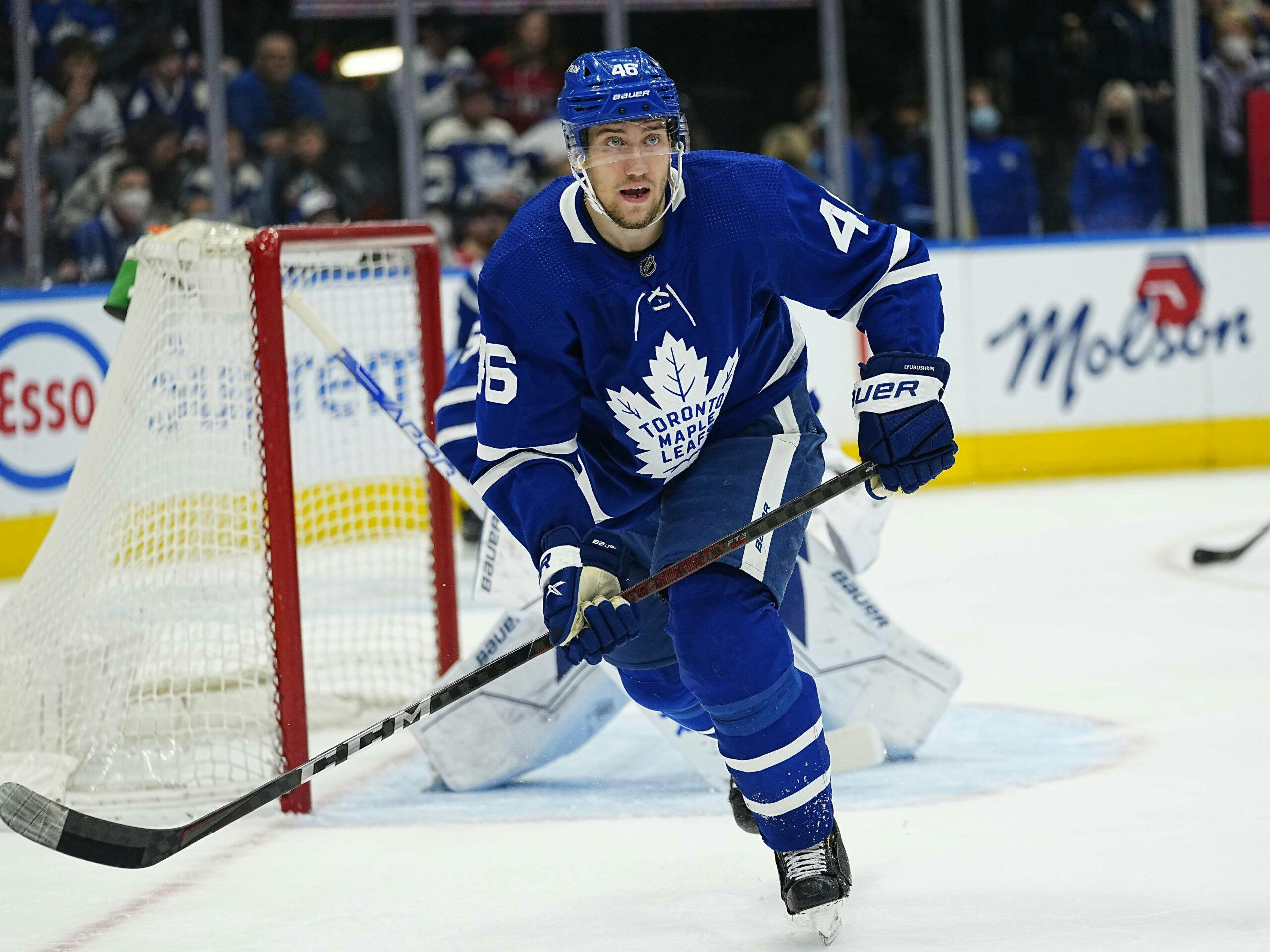
Maple Leafs Acquire Defenceman Ilya Lyubushkin

The Toronto Maple Leafs announced today that the hockey club has acquired defenceman Ilya Lyubushkin and the rights to unsigned draft choice Kirill Slepets in a three-team trade with the Anaheim Ducks and Carolina Hurricanes.
Anaheim will receive Toronto’s third-round pick in 2025 and retain 50% of Lyubushkin’s salary. Carolina will receive a sixth-round pick in 2024 and retain 50% of Lyubushkin’s remaining salary. The average annual value of the contract with the Maple Leafs will be $687,500.
Lyubushkin, 29, has appeared in 55 games for Anaheim this season, recording four assists. The Moscow, Russia native has skated in 334 NHL games, registering 43 points (five goals, 38 assists). The 6’2, 200-pound defenceman was previously acquired by Toronto during the 2021-22 season. He skated in 31 regular season games and seven playoff games for the Maple Leafs.
Lyubushkin originally joined the Arizona Coyotes as a free agent in May of 2018.
The Toronto Maple Leafs are bringing back defenceman Ilya Lyubushkin.
A night after Chris Tanev dropped off the board, the Leafs swung a trade for the next closest thing (or something close to it anyway) in Lyubushkin, a former Leaf who fit well with Morgan Rielly for a short time in 2022.
Lyubushkin came at the cost of a third and sixth-round pick, but that’s only because the Anaheim Ducks retained 50 percent of his salary while the Carolina Hurricanes took on an additional 25 percent — making him a $687,500 player for Toronto. That’s currently below the threshold of the NHL’s minimum salary. As a result, the Leafs have left themselves with plenty of cap room to maneuver on further transactions before the March 8 trade deadline. The Leafs also received the reserve rights to 24-year-old Russian forward Kirill Slepets, a fifth-round pick of the Hurricanes in 2019.
That’s less than the price the Dallas Stars surrendered to acquire Tanev. That cost a second-round pick, conditional third-round pick, and prospect.
Tanev is the better player, clearly, but not so much better to justify the difference in cost, especially when you factor in, well, the Leafs not having a second-round pick until 2027.
They were unwilling to meet Calgary’s ask of a first-round pick for Tanev.
What the Leafs get in Lyubushkin is a feisty defenceman who they know can play with Rielly and, importantly, a righty on defence. In Thursday’s win over the Arizona Coyotes, Mitch Marner had to take reps on at right D.
The rankings for who has fit best with Rielly over the years probably looks something like this:
1. TJ Brodie (before this season)
2. Luke Schenn
3. Ilya Lyubushkin
4. Ron Hainsey
There’s a pattern there, obviously, and it comes down to simplicity. Defenders who play simple — almost boring — uncomplicated games, allow Rielly to do Rielly things. They stand in the right places, they defend and defend hard.
That’s Lyubushkin.
Unlike with Tanev, or anyone else for that matter, the Leafs already know that Lyubushkin can play with Rielly.
During a first-round series against Tampa Bay in 2022, Rielly and Lyubushkin played approximately 83 five-on-five minutes together: The Leafs won around 50 percent of the expected goals. Perfectly serviceable in difficult terrain (43 percent offensive zone faceoff percentage) that saw the twosome countering the likes of Anthony Cirelli, Brayden Point and Alex Killorn, with some Nikita Kucherov and Steven Stamkos mixed in.
Leafs coach Sheldon Keefe also moved Rielly around here and there in that postseason, playing him at times with Jake Muzzin, Brodie, and Mark Giordano.
With Lyubushkin back on board, the Leafs coach can proceed similarly, sticking Rielly out there for offensive zone faceoffs with Timothy Liljegren, for instance (assuming Liljegren isn’t traded or out of the lineup).
Lyubushkin averaged just under 14 minutes in those 2022 playoffs. He figures to see a bit more than that given the current state of things on the Leaf defence.
Of course, the sticking point with Lyubushkin is he’s no automatic top-line deterrent like Tanev. A Rielly-Lyubushkin pair won’t be Keefe’s primary answer to say, Florida’s first line in a playoff series.
Which means those duties will probably fall to one of the remaining pairs.
That could be Brodie, playing the left, with Jake McCabe. The Leafs did win a round with those two playing together (with Brodie on the right), but it was a struggle. How much of that was tied to McCabe being overwhelmed in his first NHL playoffs? How much of it was Brodie slowing down?
McCabe has played his best hockey this season on the right. Brodie has played his best hockey this season on the left. Is there a fit there?
If not Brodie-McCabe, Keefe could connect Brodie with Liljegren and hope that those two can handle primary assignments in combination with Rielly and Lyubushkin. Is that tenable? Liljegren has fallen out of the playoff rotation in each of the last two postseasons.
Keefe will have to make it work somehow, though it’s entirely conceivable the Leafs add another defender ahead of the deadline. The Leafs are up to 24 players with Lyubushkin, meaning another roster move will be required before 5 p.m. on Friday.
Lyubushkin will be 30 in April. A short-term extension, if the price is right, also makes some sense.
He’s a familiar face returning at a time of need.





